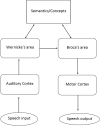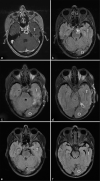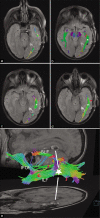A case of aphasia due to temporobasal edema: Contemporary models of language anatomy are clinically relevant
- PMID: 32874715
- PMCID: PMC7451163
- DOI: 10.25259/SNI_351_2020
A case of aphasia due to temporobasal edema: Contemporary models of language anatomy are clinically relevant
Abstract
Background: Understanding the anatomy of language in the human brain is crucial for neurosurgical decision making and complication avoidance. The traditional anatomical models of human language, relying on relatively simple and rigid concepts of brain connectivity, cannot explain all clinical observations. The clinical case reported here illustrates the relevance of more recent concepts of language networks involving white matter tracts and their connections.
Case description: Postoperative edema of the ventral occipitotemporal cortex, where modern network models locate a crucial language hub, resulted in transient severe aphasia after a subtemporal approach. Both verbal comprehension and expression were lost. The resolution of edema was associated with complete recovery from phonetic and semantic dysfunction.
Conclusion: Complete aphasia due to a functional disturbance remote from the areas of Broca and Wernicke could be explained by contemporary neuroanatomical concepts of white matter connectivity. Knowledge of network-based models is relevant in brain surgery complication avoidance.
Keywords: Aphasia; Connectivity; Language; Networks; White matter tracts.
Copyright: © 2020 Surgical Neurology International.
Conflict of interest statement
There are no conflicts of interest.
Figures



References
-
- Axer H, Klingner CM, Prescher A. Fiber anatomy of dorsal and ventral language streams. Brain Lang. 2013;127:192–204. - PubMed
-
- Catani M, Jones DK, Ffytche DH. Perisylvian language networks of the human brain. Ann Neurol. 2005;57:8–16. - PubMed
-
- Catani M, Schotten MT. A diffusion tensor imaging tractography atlas for virtual in vivo dissections. Cortex. 2008;44:1105–32. - PubMed
-
- Chen LF, Yu XG, Bu B, Xu BN, Zhou DB. The retrosigmoid approach to petroclival meningioma surgery. J Clin Neurosci. 2011;18:1656–61. - PubMed
Publication types
LinkOut - more resources
Full Text Sources
